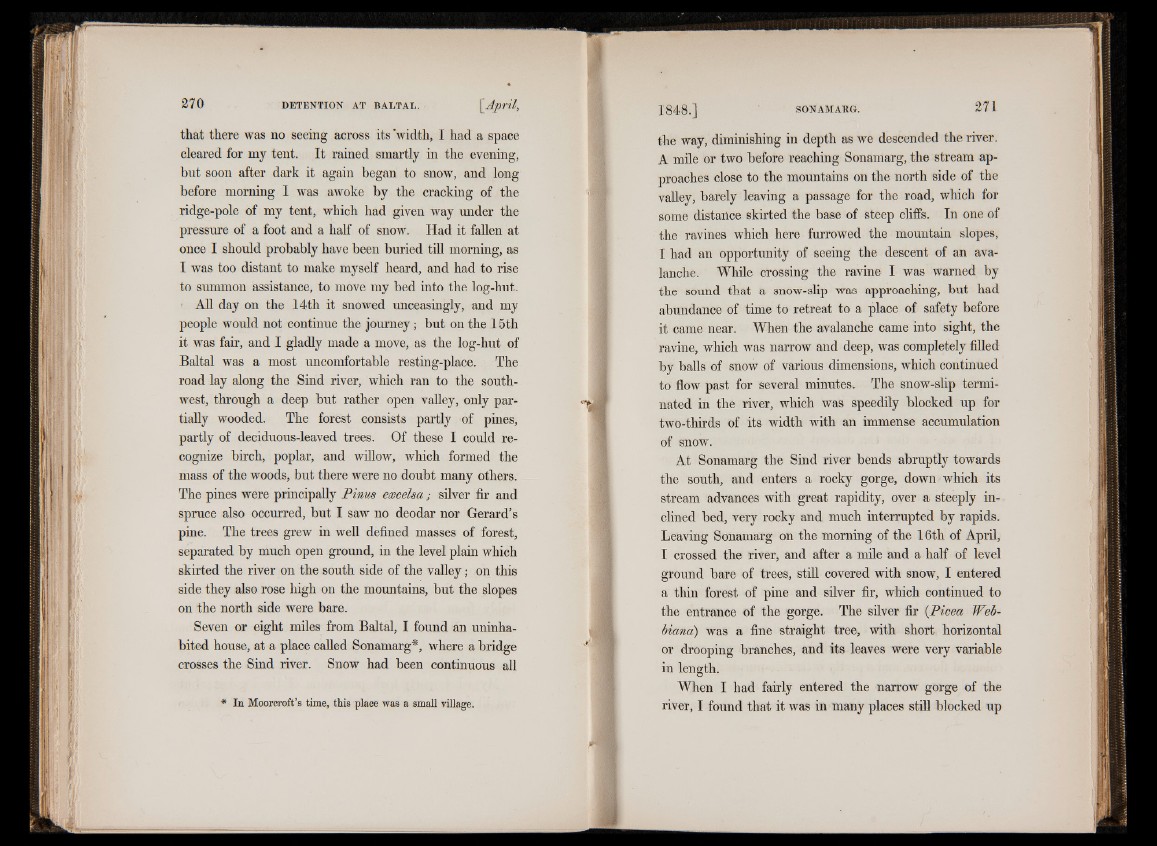
that there was no seeing across its width, I had a space
cleared for my tent. It rained smartly in the evening,
but soon after dark it again began to snow, and long
before morning I was awoke by the cracking of the
ridge-pole of my tent, which had given way under the
pressure of a foot and a half of snow. Had it fallen at
once I should probably have been buried till morning, as
I was too distant to make myself heard, and had to rise
to summon assistance, to move my bed into the log-hut.
' All day on the 14th it snowed unceasingly, and my
people would not continue the journey; but on the 15th
it was fair, and I gladly made a move, as the log-hut of
Baital was a most uncomfortable resting-place. The
road lay along the Sind river, which ran to the southwest,
through a deep but rather open valley, only partially
wooded. The forest consists partly of pines,
partly of deciduous-leaved trees. Of these I could recognize
birch, poplar, and willow, which formed the
mass of the woods, but there were no doubt many others.
The pines were principally Pinus excelsa; silver fir and
spruce also occurred, but I saw no deodar nor Gerard’s
pine. The trees grew in well defined masses of forest,
separated by much open ground, in the level plain which
skirted the river on the south side of the valley; on this
side they also rose high on the mountains, but the slopes
on the north side were bare.
Seven or eight miles from Baital, I found an uninhabited
house, at a place called Sonamarg*, where a bridge
crosses the Sind river. Snow had been continuous all
* In Moorcroft’s time, this place was a small village.
the way, diminishing in depth as we descended the river.
A mile or two before reaching Sonamarg, the stream approaches
close to the mountains on the north side of the
valley, barely leaving a passage for the road, which for
some distance skirted the base of steep cliffs. In one of
the ravines which here furrowed the mountain slopes,
I had an opportunity of seeing the descent of an avalanche.
While crossing the ravine I was warned by
the sound that a snow-slip was approaching, but had
abundance of time to retreat to a place of safety before
it came near. When the avalanche came into sight, the
ravine, which was narrow and deep, was completely filled
by balls of snow of various dimensions, which continued
to flow past for several minutes. The snow-slip terminated
in the river, which was speedily blocked up for
two-thirds of its width with an immense accumulation
of snow.
At Sonamarg the Sind river bends abruptly towards
the south, and enters a rocky gorge, down which its
stream advances with great rapidity, over a steeply inclined
bed, very rocky and much interrupted by rapids.
Leaving Sonamarg on the morning of the 16th of April,
I crossed the river, and after a mile and a half of level
ground bare of trees, still covered with snow, I entered
a thin forest of pine and silver fir, which continued to
the entrance of the gorge. The silver fir (Picea Web-
biana) was a fine straight tree, with short horizontal
or drooping branches, and its leaves were very variable
in length.
When I had fairly entered the narrow gorge of the
river, I found that it was in many places still blocked up